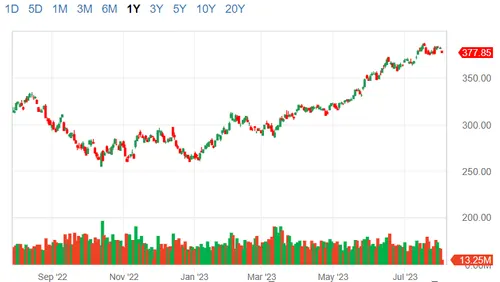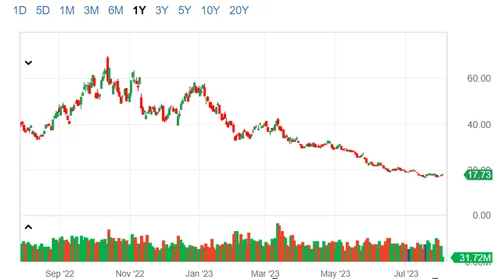Our partner, XM, lets you access a free demo account to apply your knowledge.
No hidden costs, no tricks.

ETFs are popular financial instruments that track a basket of investments to disperse the risk associated with singular securities and to give investors a broader exposure to certain markets.
Some ETFs are actively managed and are frequently adjusted, while others are passive and track the performance of existing market indices, such as the S&P 500.
However, simply buying shares in an ETF limits the upside potential for investors, as their portfolio only grows when the share price of the ETF increases.
To give investors an alternative, many financial institutions offer inverse ETFs that are composed of derivatives of an underlying basket of assets to gain from the downside.
For example, an inverse S&P 500 ETF may be holding short positions for the index - profiting investors from the downside.
Inverse ETFs are especially useful during market downturns, as they allow savvy investors to reshape their strategies to profit from the downward shift in the market.
If you are interested in what inverse ETFs are and how they work, this Investfox guide is for you.
Inverse ETFs, also known colloquially as “bear ETFs”, or “short ETFs”, are exchange-traded funds that seek to make profits from the downward movement of the underlying assets. This is to allow investors to gain from market downturns.
Here’s how a basic inverse ETF works:
Inverse ETFs serve a very important function in investor portfolios. Most investors choose inverse ETFs to either hedge against their existing positions, or to profit from an anticipated drop in an underlying index.
For example, an investor who expects a market crash may invest in an S&P 500 inverse ETF to gain as the markets drop. In a way, it can be thought of as short selling.
Another benefit of inverse ETFs is the introduction of leverage. Many inverse ETFs are leveraged and allow investors to amplify their gains as the market dips. This is especially attractive for contrarian investors, as many such trades can result in losses while yielding lower returns. Adding leverage into the mix provides an opportunity to increase returns from such trades.
For instance, a 3X leveraged inverse ETF of the ARKK ETF will gain triple the amount when the ETF drops. This happens because the inverse ETF is composed of short positions and put options of the target ETF/index to greatly increase the returns to investors.
It must be noted that daily rebalancing can make inverse ETFs more attractive for short-term hedging, rather than long-term holding, which is far riskier.
The process of trading inverse ETFs is the same as any other ETF, as shares are sold on the market, and can be bought and sold at will.
However, what makes inverse ETFs different, is the degree of leverage, as well as the daily rebalancing that takes place. As inverse ETFs are designed to deliver the opposite performance of an underlying index, they need to be rebalanced daily to maintain a level of returns that was promised to investors.
For example, a 2X ETF must always deliver twice the returns when the target index goes down. This is achieved by a complex strategy that involves short-selling and putting options that target the underlying index to achieve the desired return level.
Another important factor to consider is the higher expense ratios of inverse ETFs, as opposed to regular ETFs, which can eat into your profits.
Market crashes and steep declines in indices are where inverse ETFs truly shine. A leveraged inverse ETF can greatly increase the returns from a crash - leaving investors better off despite the market being in jeopardy.
However, it is important to note that such events can be few and far between, which makes it difficult to rely on inverse ETFs for consistent returns. This is why most investors use inverse ETFs as a means of hedging their existing portfolios to mitigate losses and possibly make extra profits during downturns.
Let’s consider a practical example of how ETFs and inverse ETFs differ and how changing market conditions can lead to vastly different returns thanks to leverage:
Now, let’s look at the performance of each ETF over the past 12 months:

The QQQ ETF has returned 19.71% over the past 12 months.

The SQQQ has lost 55.59% over the same period. This clearly illustrates that despite the fact that these two ETFs are inversely correlated, the 3X leverage of SQQQ means that its loss potential is also three times as high as that of QQQ.
Before investing in inverse ETFs, it is crucial to understand the inherent benefits and risks associated with doing so. Inverse ETFs are complex financial instruments that require an extensive knowledge of the markets to use profitably.
Our partner, XM, lets you access a free demo account to apply your knowledge.
No hidden costs, no tricks.
Inverse ETFs are exchange-traded funds that seek to benefit from the opposite movements of their target ETF. For example, an investor anticipating a decline in a major index may invest in an inverse ETF which allows them to gain as the underlying index of the target ETF drops.
Some inverse ETFs are leveraged, which allows investors to amplify the gains from the downward movements of the underlying index.
For example, a 2X inverse ETF tracking the S&P 500 will have invested in a number of derivatives to double the profits from a decline in the price of the S&P 500.
Inverse ETFs can be highly rewarding during market downturns. When investors anticipate a broad decline in major market indices, they can invest in the inverse ETFs of those tracking said indices, which allows them to profit from the market downturn.